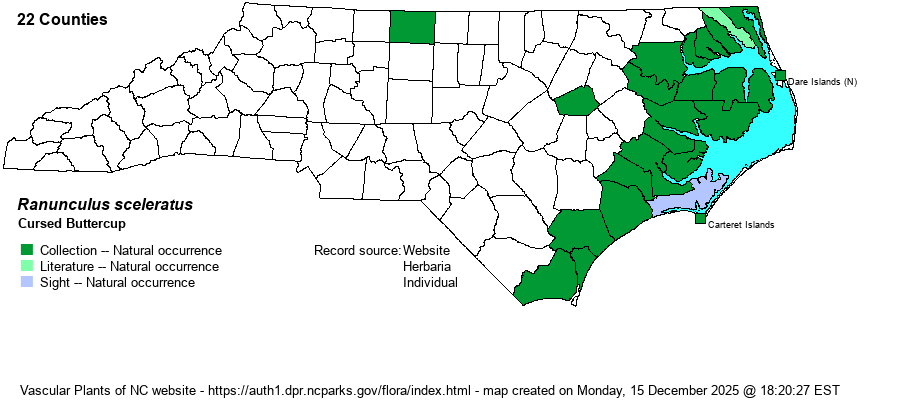| Author | L. | |
| Distribution | Essentially found in the eastern Coastal Plain, mostly in or close to tidal waters, including the upper ends of embayed rivers. A specimen from Rockingham County in the central Piedmont seems bizarre, but VA has a handful of records just across the border, as shown on the map on the Digital Atlas of Virginia Flora website. That does not mean these are natural occurrences, however.
This is a very widespread North American and European species, but in eastern North America it is rather limited. It is very sparse in the Piedmont, Mountains, and Ohio and Tennessee river regions. Weakley (2018) mentions that it is partly introduced in the southern parts of the range. | |
| Abundance | Infrequent in the eastern Coastal Plain, most records probably representing natural occurrences, but some presumably not. Extremely rare farther inland. The website editors feel that a State Rank of S3 is better than the NCNHP's rank of S2?, based on specimens from not only 18 counties but from nearly all counties that border tidal water. | |
| Habitat | This is a marsh species, being found mostly in mud -- such as in drawdown zones of various water bodies, in ditches, openings in marshes, and in wet scrapes. Many of the records in NC are from man-created/disturbed places. | |
| Phenology | Blooms from April to September, and fruits shortly after flowering. | |
| Identification | This is a moderately tall buttercup, but as it has small flowers, it is easily passed over by biologists. It is an erect and smooth species, reaching to about 1-1.5 feet tall, but it has succulent stems and leaves, with a hollow stem. The basal and cauline (stem) leaves are similar; the basal are on long petioles and are strongly divided into 3 segments, each narrowed at the base, with toothed margins. The leaves are about 2-3 inches long and wide. The upper stem has several branches, with the tips of the branches ending in small flowers. The petals are light yellow and about 1/5-inch long, with the sepals about the same size; thus, a flower has a spread of only about 2/5-inch across. Thankfully, each plant has numerous flowers, which should catch your attention if you find the plant in bloom. As with a number of marsh/mud species, the whole plant tends to look quite shiny and waxy. This species looks a bit "bushier" than most other marsh/swamp buttercups with small flowers, several -- such as R. pusillus -- of which are quite slender and wispy! | |
| Taxonomic Comments | Not surprisingly owing to its huge range, the taxon in NC is a named variety - R. sceleratus var. sceleratus.
| |
| Other Common Name(s) | Celery-leaved Crowfoot, Cursed Crowfoot | |
| State Rank | S2? [S3] | |
| Global Rank | G5 | |
| State Status | | |
| US Status | | |
| USACE-agcp | OBL link |
| USACE-emp | OBL link |

